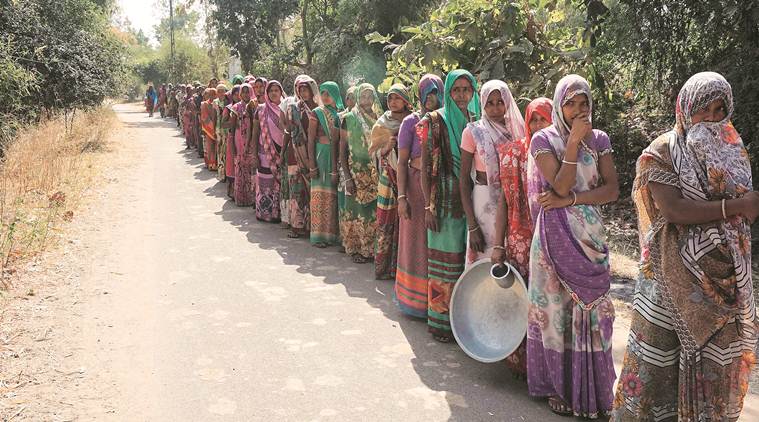
Dalkiben Rathwa, 48, her face covered with saree, but the wounds on her arms and legs exposed as she sits in front of her two-room mud house at Vavdi village of Chhota Udepur’s Pavi Jetpur taluka.
Nursing her wounds, she recalls the early winter January morning three weeks ago, when a leopard attacked her husband, 50-year-old Balu, while he was plucking cotton at their farm.
“The leopard appeared out of no where. For the past 20 years, we have been farming at the same place. Never before did we see a leopard during day time. That day, I tried to fight it to release my husband from its clutches. But it was huge, much stronger than me,” Dalkiben says.
After she raised an alarm, she says, two farmers working at a farm nearby, rushed to their aid. They chased the animal with sticks, but by then, Balu was dead.
“We took our cattle along but it did not attack them. The leopard did not attack me either,” she adds.
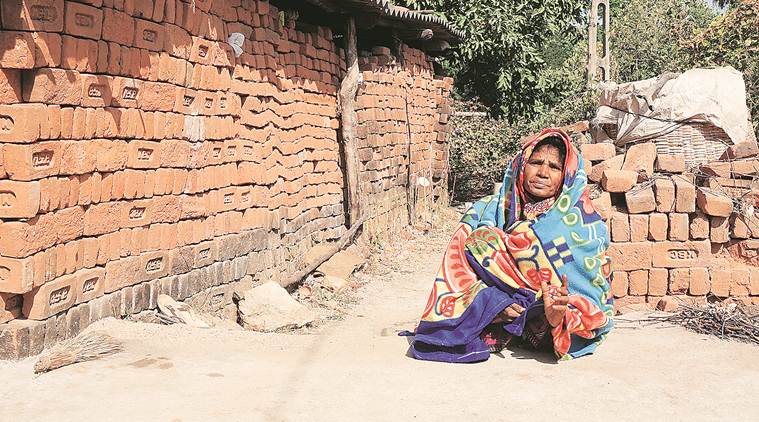
While Dalkiben is struggling to come to terms with her loss, the villagers are now living in fear.
The streets are deserted after nightfall, with farmers cutting their work hours. Instead of going to their fields by 7 in the morning, they now reach by 9 am, when there is enough light. Similarly, they don’t work till dusk, and return home by 4 in the evening. This time-table, however, may pose a problem as the government, during alternate weeks, supplies water for irrigation between 8 pm and 4 pm.
“Earlier, whenever the dogs would bark, we knew that a leopard was on the prowl. It would prey on dogs and goats. We would light a fire to scare it away or throw stones at it. But never did it attack a human so brutally,” says 40-year-old Jangu Rathwa of the village. The villagers have also taken it upon themselves to keep night vigil.
About five kilometres from Vavdi, another village, Bandi, is under siege after three leopard attacks were reported in a single day, leaving two injured and killing a two-year-old boy.
Surrounded by cotton and tomato farms, the village is three kilometres away from where the forest starts.
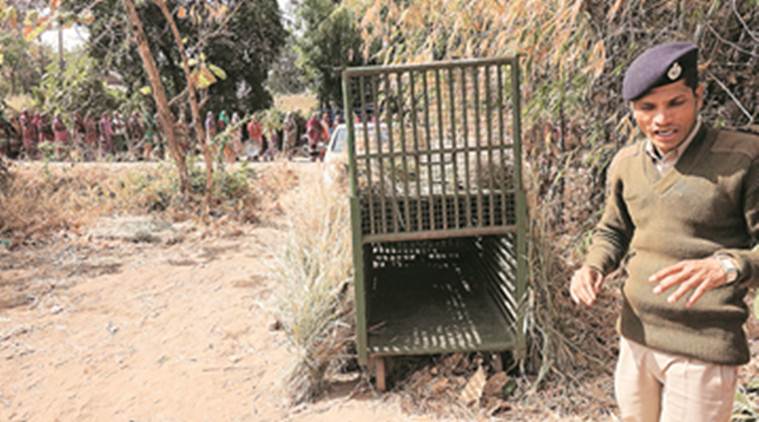
On January 6, a leopard first attacked an eight-year-old girl who was in her farm. The girl, currently undergoing treatment at SSG Hospital in Vadodara, is reportedly in a critical condition. While most of the villagers were at the hospital with the girl, the leopard sneaked into another house and dragged two-year-old Chirag Rathwa towards the forest. As his mother raised an alarm, the leopard dropped the child in a tomato field adjacent to his house and fled.
With the nearest hospital 15 km away, the child succumbed to injuries on the way.
“How is my family safe now? Had the attack been in the forest, we would have stopped going there, but it was right here, outside my house,” says the boy’s father, Chiman Rathwa.
The third attack of the day was on Ramsinh Rathwa, who also sustained injuries.
However, these attacks, especially the one on Ramsinh, provoked his brother Hindu Rathwa to open fire at a leopard suspected to have attacked the three persons. The leopard was rescued and died two days after the incident at a rescue centre.
Hindu Rathwa was arrested and is in the jail since.
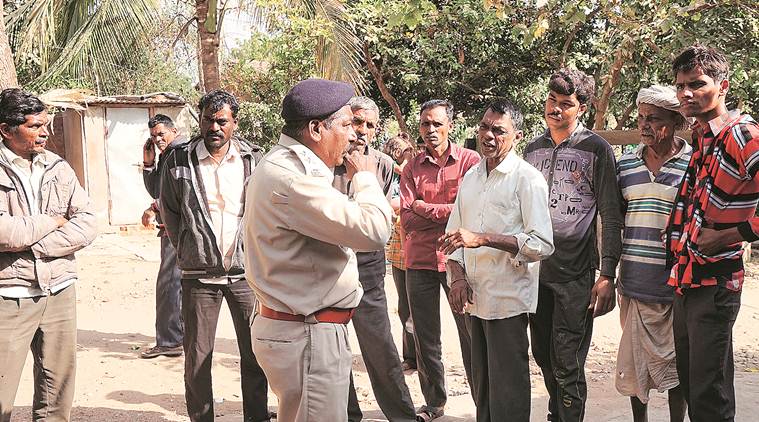
The villagers, meanwhile, have chalked out some security measures — they now lock their cattle after nightfall, and the men of the village stand guard in turns.
“The forest range is visible from our village. For the next few days, the men in the village have decided to guard their houses in groups or individually. We have kept knives, bows and arrows handy for self-defence, in case such attacks happen again. We have prohibited women and children from the village from venturing into the farms or forest early in the morning or after sunset. Even during day time, we are advising everyone to go out in groups,” says Vikram Rathwa (59), grandfather of the eight-year-old girl attacked by a leopard.
Meanwhile, in neighbouring Dahod district, memories of a series of attacks that claimed 11 lives in 2003 have again been stirred up in the three villages of Dumka, Kotambi and Bhanpur.
Women at Kotambi and Dumka villages would make at least two trips in a week, to the Dhanpur forest range to collect firewood. On November 21, last year, 12-year-old Ashwinta Pasaya made her first such trip. She, along with her aunt, went to the forest as her school was closed for the day.
When the leopard attacked, the women ran for help. However, the leopard had caught hold of the girl and dragged her into the forest. Her body was found from the forest later.
“The school was closed that day. So, at 6.30 am we set out on foot for the forest. We wanted dried wood which is found deep inside the forest. Women regularly venture these parts of the forest, but never before was there a leopard attack. Now, we have stopped going to the forest,” says Bakuben, the victim’s aunt.
At Kotambi village, close to where the attack took place, villagers still live in a sense of deep fear. After sunset, villagers venture out in groups. The forest which was regularly visited by women of the village to collect firewood, at least twice a week, has been completely abandoned.
On November 26, 64-year-old Mathuri Ganava, a resident of Bhanpur village had gone to Vasiya Dungri forest on the Gujarat-Madhya Pradesh border. Ganava was attacked and dragged inside the forest by a leopard. The women, who had accompanied Ganava, rushed to get help. However, when the others reached the spot, Ganava’s decapitated body was found, and her face eaten beyond recognition.
Fresh scat of the leopard was found on the 30-minute trek The Indian Express undertook to reach the spot where Ganava’s body was found. The forests near both villages, which were earlier frequented by women for wood, are now abandoned.
Range Forest Officer (Vasiya Dungri) Mahesh Parmar, who has been serving since 1999, says that after the area returned to normalcy following the 2003 leopard attacks, no one had expected the incidents to recur.
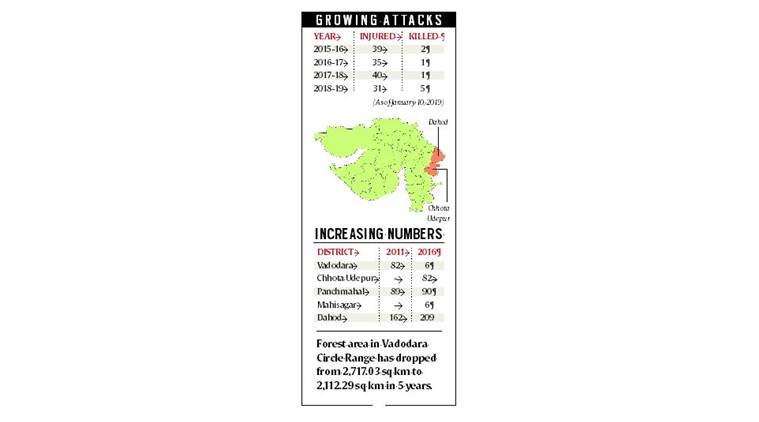
Eleven persons had died and 21 others were injured in the leopard attacks in the Dhanpur range between August 25, 2003 and September 18, 2003.
Following a rescue operation, which included senior forest officers from across the state, three leopards were shot dead and 12 others were captured and sent to rescue centers. “During the 2003 attacks, the youngest victim was a seven-year-old girl from Ulkadar village. She had gone to the forest to graze cattle but did not return home that evening. After a three-day search, we found her head while her body was missing. From the bite marks we ascertained that it was a leopard attack,” Parmar says.
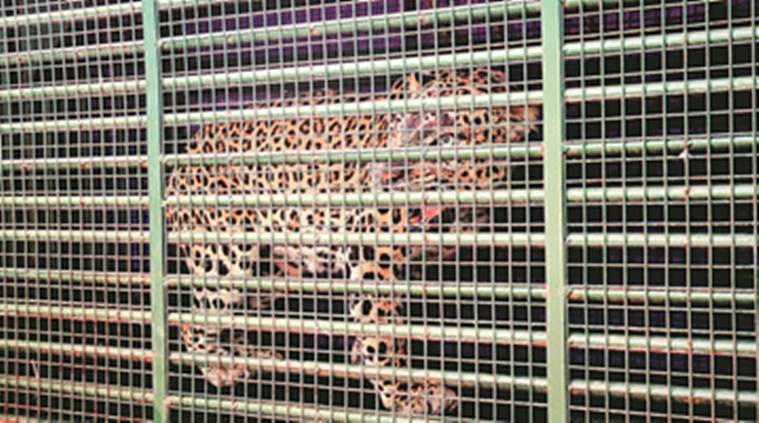
Foresters, analysing the traits of the leopards in the area, have noticed changes in the behavioural patterns of the leopards, which they have credited to an increase in the population of the animals and a reduction in the habitat cover.
As per the Forest Department data, the population of leopards has increased by at least 29 per cent in the last five years. According to the 2016 census, there are 291 leopards in the Central Gujarat range. Of these, 209 are in forests of Dahod itself.
In Dahod alone, the number has increased from 162 in the 2011 to 209 in 2016.
The data further reveals that the forest area in the Vadodara Circle Range has dropped from 2,717.03 sq km in 2014-15 to 2,112.29 sq km in 2017-18. However, the area reduced is still counted as forest which has either been diverted under the Forest Conservation Act (FCA) or Forest Reservation Act (FRA).
Forest area is calculated under the Forest Conservation Act and Forest Reservation Act. Under the FRA, forest areas are given to people residing in the tribal belts but in many instances, they begin farming in those allotted forest areas or use food for other purposes, thus depleting the forest cover.
This reduction in forest areas and the increasing leopard population is putting a strain on the available food resources as well.
Leopards generally prey on rodents, small birds, monkeys, goats, fish, deers in their natural habitat. With a diminishing green cover, these small animals have also moved to farms and villages for their food consumption. This has further lowered the prey base for the wild cats in the forest.
According to officials, with a shrinking habitat, the movement of humans in the forests has also increased.
The big spotted cat which has a high survival instinct in all kinds of environment can stay hungry for up to three days after eating 3 kg of food in a single day.
The behavioural changes, Chhota Udepur Divisional Forest Official Nilesh Pandaya says, include a shift in their mating period in some of the leopards. He says that from mating in specific seasons, some of the animals have now started mating all year round, thus the “changes in their behaviour which includes preying on humans”.
“With changes in climatic condition and disturbance in habitats, a few leopards have shown erratic changes in their mating behaviour. The leopards, mostly male tend, to be aggressive in the absence of a female which can lead to attacks on humans,” officials say.
Similar observations in the Chhota Udepur attacks revealed that leopards were attacking humans out of revenge.
“We found the carcass of a female leopard and feel that the male might have seen someone kill her, and the spate of attacks were to avenge the killing,” Pandaya says.
The leopard carcass was found in Zab village of Pavi Jetpur taluka in Chhota Udepur, on January 8, with its legs, head and tail missing. The carcass was three-four days old.
While the forest officials were investigating the death of the leopard for suspected poachers, another leopard was found injured at Bandi village. The leopard was taken to Pavagadh Rescue Centre. The investigation led forest officials to Hindu Rathwa, brother of Ramsinh Rathwa, who had shot the leopard following the attacks in the village.
“Yet another reason for the attacks can be that the leopard was hungry and ventured into the farm. The man in the farm was bowing down and might have seemed like a four-legged animal to it. Though after attacking a human they can decipher that its a human but the first attack could have given him the confidence to carry out more attacks,” Pandaya says.
Meanwhile, foresters have started conducting camps in villages to help residents understand how to co-exist with the animal.
“It is a fact that due to government policies, efforts and people’s cooperation, the population of leopards has increased. This will lead to more attacks. So, people must learn the art of mutual co-existence. By nature, leopards do not attack humans. Any attack is rare and usually happens only when the animal is not able to hunt otherwise. But people should have faith in the department’s intentions and capabilities, show some patience and more importantly should not take law in their hands. With a bit of care, we can set a good example of co-existence,” says Chief Conservator of Forest, Vadodara Circle, SK Srivastava.